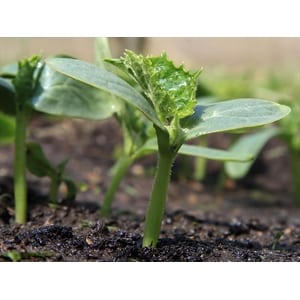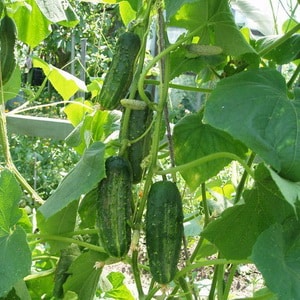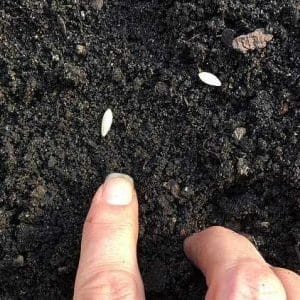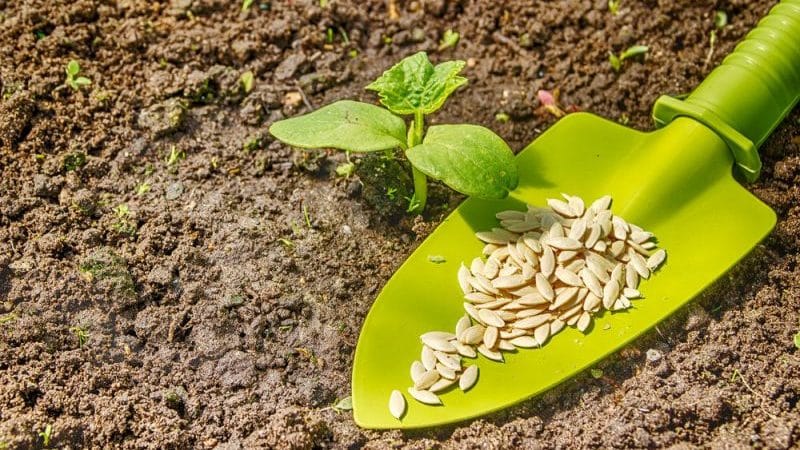Recommendations for planting cucumber seeds in open ground in July
Our usual and beloved cucumber was brought to Russia only in the 16th century. The vegetable's homeland is the foothills of the Himalayas. There this plant is still found in the wild.
Probably every gardener has tried to grow cucumbers on his plot at least once. Traditionally, seedlings are grown at home in May, and then, with the arrival of warmer weather, the plants are planted in a permanent place. Planting cucumbers in open ground with seeds in July is an unusual and new thing for our compatriots. We will tell you in detail how to plant cucumber seeds in mid-summer and care for the plantings.
Advantages and disadvantages of late sowing
Sowing cucumber seeds in July will provide you with fresh, crisp fruits before frost arrives.
Late sowing has a number of advantages:
- at the moment the first shoots appear, it is no longer so hot, but still warm enough for formation and fruit ripening;
- cucumber seeds have fast germination;
- rational use of beds freed from early vegetables and herbs.
However, this growing method also has a number of disadvantages, namely:
- Unpredictability of weather conditions. An early cold snap will mean that all your efforts will be in vain.
- Only early ripening varieties can be planted. Mid- and late-ripening varieties will not have time to ripen before the onset of cold weather.
- Soil used after growing other crops should be enriched with nutrients.
Suitable varieties for sowing in July
For planting in mid-summer, preference is given to early varieties and hybrids with a growing season of up to 50 days. The cucumber crop is very heat-loving, therefore, when planting seeds in July, choose a variety that will have time to produce a harvest before the onset of cold weather.
Attention! When planting in open ground in mid-summer, take into account one more factor - the survival rate of the variety in your area and maximum adaptation to the climatic conditions of the region.
By choosing the variety correctly, you will get a stable harvest that will not suffer from diseases and adverse weather conditions.
We list several popular early varieties and hybrids suitable for sowing and growing in open ground in mid-summer:
- Altai early 166. Early ripening, productive variety. It was zoned back in 1958, but is still popular among gardeners. The first harvest is harvested 37-40 days after emergence. Resistant to diseases of fungal origin and cold snaps. The fruits are small - on average 10 cm in length.

- Herman F1. Self-pollinating productive hybrid. The first fruits are harvested 40-45 days after emergence. A distinctive feature of the hybrid is its long fruiting period. Resistant to cucumber mosaic virus and powdery mildew.
- Muromsky 36. One of the fastest ripening varieties - the first harvest is harvested after 32-42 days. The length of the fruit is 7-10 cm. It actively bears fruit for about 4 weeks. Ripe fruits quickly turn yellow, so you need to harvest them regularly.
- Moscow dude F1. Bee-pollinated early ripening hybrid. The fruits ripen 40-45 days after emergence. Cucumbers reach 10-12 cm in length. They are resistant to bacteriosis and spotting.
- Finger. Bee-pollinated variety.From the emergence of seedlings to the beginning of fruiting, 42-45 days pass. Cucumbers reach 10-14 cm in length. The variety is resistant to downy mildew. It bears fruit for a long time - up to 60 days.
- Valdai F1. Bee-pollinated hybrid. The fruits ripen 48-50 days after emergence. The plants are vigorous and resistant to unfavorable growing conditions. The fruits are cylindrical, 10-12 cm in length. The hybrid is specially bred for processing.
Features of July sowing

For July sowing, beds that are free of greens and early vegetables are used. Areas where early ripening potatoes, radishes, lettuce, and winter garlic used to grow are well suited. It is enough to dig up the soil and remove plant debris.
In the Urals and Siberia, it is preferable to plant cucumbers in July using seedlings. To do this, at the beginning of summer, seeds are sown in separate cups, previously soaked in a damp cloth for several days. The glasses are filled with fertile soil mixture.
In the Moscow region and in the south of Russia, direct sowing of cucumber seeds in the ground is used (seedless method). To protect the sprouts from sunlight and dry winds, the beds are placed in the partial shade of tall plants.
Advice. To get a guaranteed harvest of cucumbers by autumn, plant them in 2-3 stages with a break of 2 weeks.
After planting in open ground, it is good to cover the seedlings with non-woven material for the first time. This will protect tender young plants from temperature changes and daytime heat.
Technology for planting in open ground in July
The technology for planting cucumbers in open ground in July is similar to the technology for spring planting. Preparation for sowing begins with cultivating the area.
Soil preparation
All plant debris is removed from the selected bed. The soil is dug up to the depth of a spade bayonet, while introducing mature compost or peat humus mixture. Rotted mullein is used as fertilizer. Add 1-2 buckets of organic matter per 1 m².
Mineral fertilizers include double superphosphate, potassium magnesium and ammonium nitrate. Instead of individual types of mineral fertilizers, complex “Nitroammophoska” is also used.
Seed preparation
Seed material is sorted, empty and small specimens are rejected. Selected seeds are disinfected in a weak solution of potassium permanganate, then washed and dried.
To improve germination, they are heated in a warm place for several days and then left for 12 hours in the Nitrophoska solution. The washed seeds are germinated in a damp cloth or wet sawdust. After the sprouts appear, they are ready to be planted in seedling cups or directly into open ground.
Planting methods and patterns
With seedling method When growing, seeds are sown in separate containers filled with nutritious soil mixture.
With seedless Sow directly into open ground.
The seeds are planted to a depth of 2-3 cm. The plantings are watered abundantly using the sprinkling method. Transplantation of seedlings is carried out in cloudy weather or in the evening to prevent damage to the leaves by scorching sun rays.
Advice. Sprinkle the top of the crops with a mixture of finely ground black and red pepper. This will protect the sprouts from ants, slugs and mice.
Sowing in open ground is carried out in two ways:
- Linear. Mark rows of 90-100 cm, make indentations at a distance of 20 cm from each other. 2 seeds are planted in each hole. Subsequently, the weak plant is removed.
- Gnezdov. Mark out square nests - 60x60 cm or 70x70 cm. Sowing rate - 3-4 pieces.Subsequently, 2-3 of the strongest plants are left in the nest.
Caring for summer cucumbers

Caring for cucumbers planted in July is generally no different from caring for spring plantings. The beds are regularly watered, the soil is loosened, and weeds are removed.
For glaze cucumber plantings use warm, settled water. It is advisable that its temperature is not lower than +25°C. Watering with cold water not only inhibits the development of plants, but also provokes the development of diseases.
Watering is carried out either early in the morning or in the evening. Water is poured under the root of the bush, avoiding drops of moisture getting on the leaves and lashes.
The next day after watering or rain, the soil is loosened. This prevents the formation of a crust on the surface of the earth, which impedes the access of oxygen to the root system. At the same time, weeds are removed that take away nutrition and moisture from the sprouts. After 2-3 true leaves grow, the plants are earthed up.
In the second half of August it gets cold at night. Therefore, at night the beds are covered with agrofibre or plastic film.
Conclusion
Planting cucumbers in July allows rational use of beds freed from early crops. To do this, choose early varieties and hybrids that will have time to produce a harvest before the onset of cold weather. The right choice of seeds and proper care will provide you with fresh vegetables until autumn, and will also allow you to prepare delicious pickles for the winter.